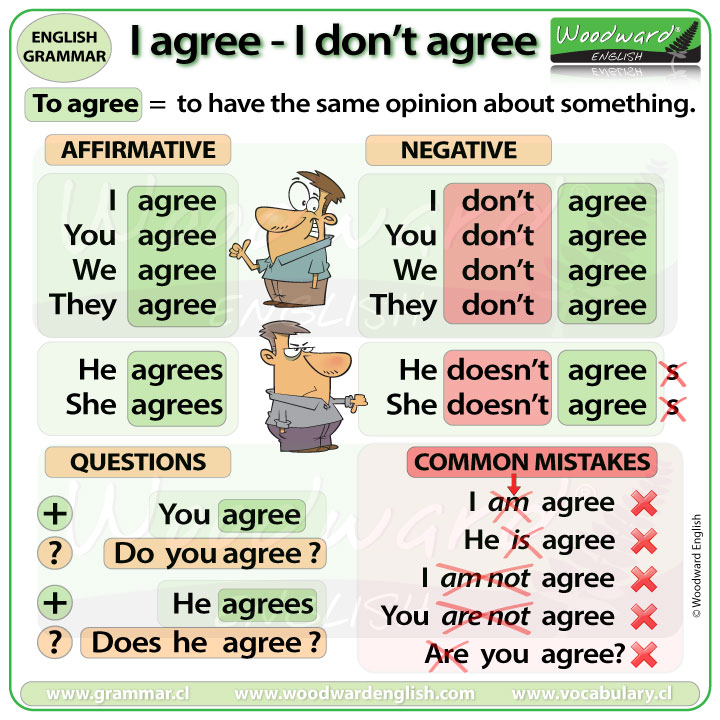Which is correct, I agree or I am agree? Do you say I don’t agree or I am not agree?
This ESOL lesson explains how to use the verb To Agree in English.
To Agree
To agree = to have the same opinion about something.
It is important to remember that agree is a normal VERB. It follows the same rules as other verbs in the simple present tense.
- I agree
- You agree
- We agree
- They agree
For third person (he and she) we just add an S to the end.
- He agrees
- She agrees
Notice how we DO NOT say:
- I am agree. (This is NOT correct – we don’t need AM)
- We are agree. (This is NOT correct – we don’t need ARE)
- He is agree. (This is NOT correct – we don’t need IS)
A common mistake for people learning English is when they use To Be with the verb To Agree. That is because some speakers of romance languages (Spanish, French, Italian…) have a habit of using To Be when agreeing in their language.
That is because they don’t have the verb To Agree.
- Spanish: Estoy de acuerdo.
- French: Je suis d’accord.
- Italian: Sono d’accordo.
Negative form of Agree
So, what is the negative from of To Agree?
As with normal verbs in the present tense, we add don’t or doesn’t to make it a negative sentence
- I don’t agree.
- You don’t agree.
- We don’t agree.
- They don’t agree.
For third person (he, she, it) we use doesn’t instead of don’t.
- He doesn’t agree.
- She doesn’t agree.
- It doesn’t agree. (again, you almost never use Agree with It)
Remember, there is no S at the end of the verb in negative sentences.
Again, for negative sentences we do NOT use the verb To Be before the verb To agree. This is a common mistake.
- I am not agree. (This is NOT correct – We don’t use TO BE. It should be….)
I don’t agree. OR I do not agree. - We are not agree. (This is NOT correct – It should be….)
We don’t agree. - He is not agree. (This is NOT correct – It should be….)
He doesn’t agree.
Another way of saying I don’t agree is I disagree.
Questions with Agree
How do you make a question using the verb Agree?
As with normal verbs in the present tense, we us DO or DOES and the beginning to make a question.
- You agree … becomes … Do you agree?
- They agree … becomes … Do they agree?
- He agrees … becomes … Does he agree?
(Remember, no S at the end of the main verb in questions) - She agrees … becomes … Does she agree?
(Again, no S at the end of the main verb)
Also avoid using the verb TO BE before the verb TO AGREE.
Do not say:
- Are they agree? (This is incorrect… it is DO they agree?)
- Is she agree? (This is also incorrect… it is DOES she agree?)
Past tense of Agree
What is the past tense form of this verb?
For affirmative sentences, if…
- the present tense is I agree.
- the past tense is I agreed. I agreed.
For the third person we also use the same form of the verb in the past tense. For affirmative sentences, if…
- the present tense is She agrees.
- the past tense is She agreed. She agreed.
With negative sentences we just replace don’t or doesn’t with didn’t to make it a negative sentence in the past tense. So…
- I don’t agree becomes I didn’t agree.
The auxiliary DIDN’T shows us that the negative sentence is in the past tense. The same happens with third person subjects…
- She doesn’t agree becomes She didn’t agree.
And finally with questions we just change Do or Does with Did.
- Do you agree? … becomes… Did you agree?
- Does she agree? … becomes… Did she agree?
We will see more about the past tense in another lesson.
Summary Chart

